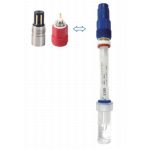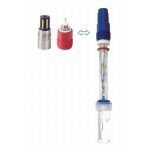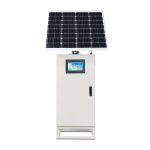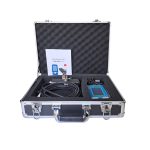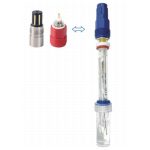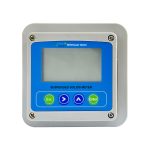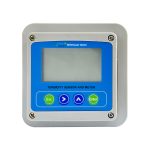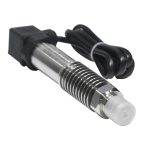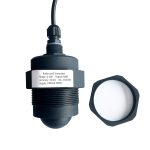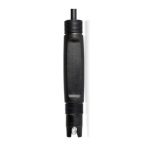WHEC-768 Digitális Vezetőképesség-érzékelő | Ipari Vízminőség-monitorozás
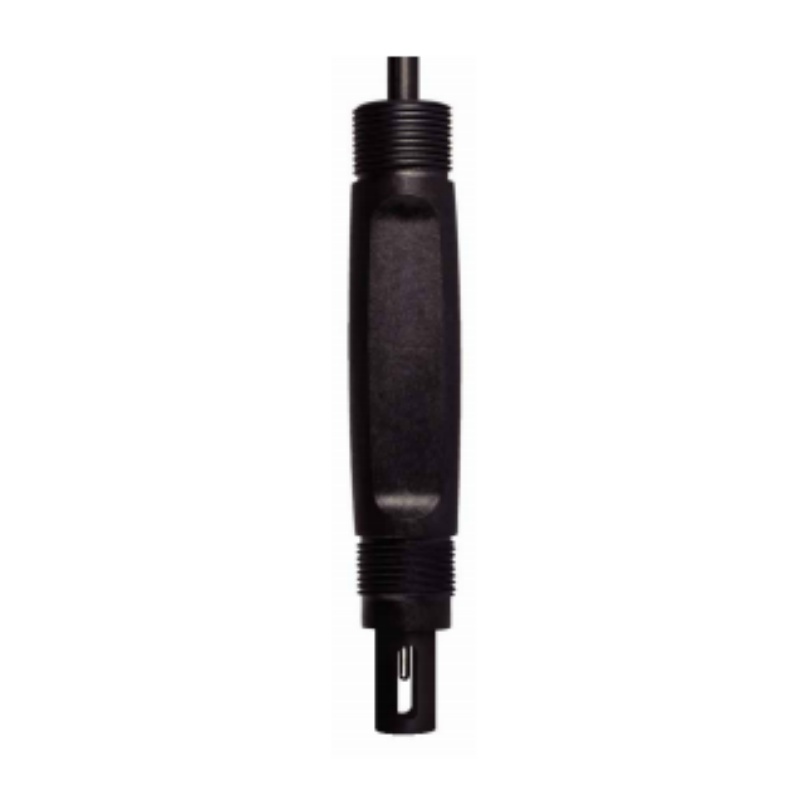
Precíziós vezetőképesség-mérés ipari vízrendszerekhez
Vizes oldatok megbízható monitorozására tervezve,
A WHEC-768 digitális vezetőképesség-érzékelő valós idejű méréseket biztosít a vezetőképességről, a TDS-ről,
és hőmérséklet. ±1%FS pontossággal,
IP68 vízállósági besorolás és MODBUS RS485 integráció,
Ez az érzékelő ideális erőművekhez, vegyipari feldolgozáshoz,
vízkezelés és ipari alkalmazások, amelyek precíz vízminőség-ellenőrzést igényelnek.
Alapvető jellemzők
- Széles mérési tartomány
- Vezetőképesség: 0–30 000 µS/cm és 0–500 000 µS/cm (kettős méréshatár tartomány)
- Hőmérséklet: 0–50 ℃, ±0,5 ℃ pontossággal az átfogó környezeti adatokhoz
- Robusztus merülő kialakítás
- Az IP68/NEMA 6P besorolás folyamatos merítést tesz lehetővé (1 m mélységig) zord környezetben
- A PP test és a 10 m-es PVC kábel ellenáll a kémiai korróziónak és a mechanikai igénybevételnek
- Intelligens csatlakozás
- MODBUS RTU (RS485) protokoll a PLC-kkel, SCADA-val és IoT platformokkal való zökkenőmentes integrációhoz
- 9–36 VDC széles feszültségkompatibilitás a rugalmas telepítés érdekében
Műszaki adatok
| Paraméter | Érték |
| Mérési tartomány | Vezetőképesség: 0–30 000 µS/cm • 0–500 000 µS/cm • Hőmérséklet: 0–50 ℃ |
| Pontosság | ±1%FS (vezetőképesség) • ±0,5 ℃ (hőmérséklet) |
| Tápegység | 9–36 V egyenfeszültség |
| Kimeneti protokoll | MODBUS RTU (RS485) |
| Anyag | Test: PP • Kábel: PVC (10 m standard) |
| Méretek | Φ30mm x 165mm |
| Súly | 0,55 kg (10 m-es kábellel) |
| Vízálló minősítés | IP68/NEMA 6P |
| Nyomásbesorolás | ≤0,3 MPa |
| Tárolási hőmérséklet | 0–45 ℃ (száraz környezet) |
| Kalibráció | 2 pontos standard oldat kalibráció (pl. 84µS/cm, 1413µS/cm) |
Alkalmazások
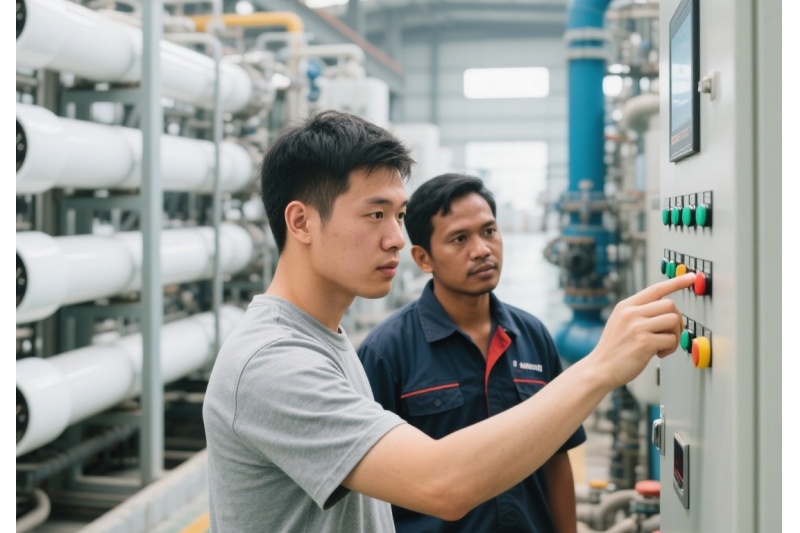

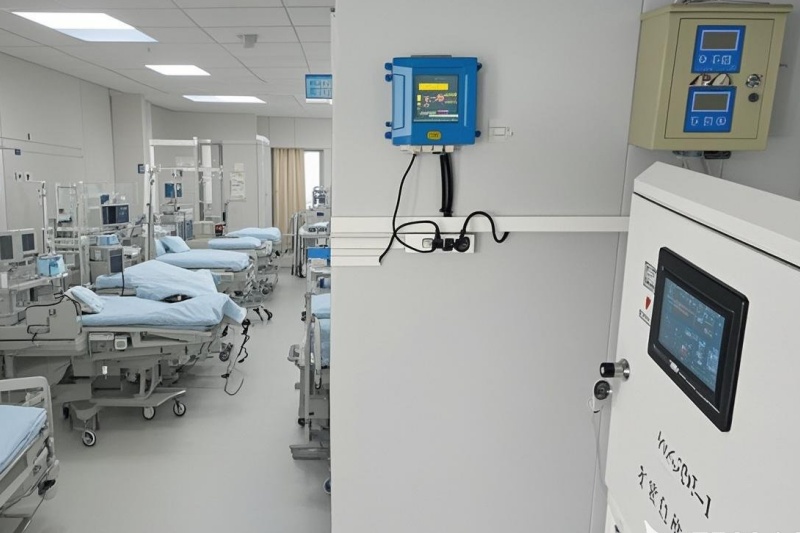
1. Tengeri sótalanítás
A WHEC-768 kritikus szerepet játszik a tengervíz sótalanító üzemekben a fordított ozmózis (RO) rendszerek vezetőképességének monitorozásával. A tápvíz vezetőképességének (jellemzően 30 000–50 000 µS/cm) és a permeátum vezetőképességének (<100 µS/cm) mérésével biztosítja az RO membrán optimális teljesítményét és a sóeltávolítási hatékonyságot. IP68-as besorolású, vegyszerálló kialakítása ellenáll a sós környezetnek való állandó kitettségnek, így 20%-vel csökkenti a karbantartási intervallumokat.
2. Elektronikai és félvezető gyártás
A félvezetőgyártásban a <0,1µS/cm vezetőképességű ultratiszta víz (UPW) elengedhetetlen a waferek tisztításához és a mikrochipek gyártásához. A WHEC-768 integrálható az elektródionizációs (EDI) rendszerekkel az ioncsere-folyamatok folyamatos monitorozása érdekében, biztosítva az UPW tisztaságát és megakadályozva a chiphibakat okozó szennyeződéseket. MODBUS RTU kompatibilitása lehetővé teszi a valós idejű adatintegrációt a gyári automatizálási rendszerekkel.
3. Kórházi vízrendszerek
A WHCOND-768 valós időben figyeli a kórházi vízrendszereket, érzékeli a vezetőképesség változásait a vízminőség biztosítása és a szennyeződés kockázatának megelőzése érdekében.
Telepítési útmutató:
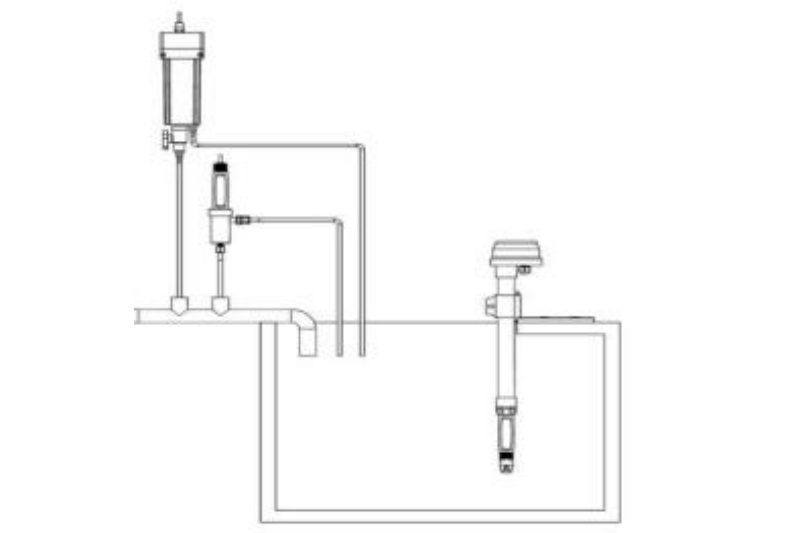
Szerelési követelmények:
- Függőlegesen telepítse, legalább 5 cm távolságot tartva a tartály/tál aljától, hogy elkerülje az üledék zavarását
- Nagy áramlási sebességű rendszereknél használjon megkerülő csövet a stabil áramlási sebesség (250–500 ml/perc) biztosítása érdekében.
- KábelrendezésVálassza le az RS485 kábeleket a tápvezetékekről; árnyékolt kábellel akár 1000 m-ig is meghosszabbítható
Kalibrációs eljárás:Helyszíni kalibrálás
- Standard oldatok elkészítéseHasználjon 84µS/cm (alacsony tartomány) vagy 1413µS/cm (magas tartomány) kalibrációs folyadékot
- MODBUS kalibrálási lépések:
- Merítse az érzékelőt az oldatba, amíg a mérési eredmények stabilizálódnak
- Használja a **06** funkciókódot a **12** cím kalibrációs értékének megadásához (pl. 1413 1413µS/cm esetén)
- A beállítások mentéséhez erősítse meg a „Válasz OK” lehetőséget
- Kétpontos kalibráció(a nagy pontosság érdekében):
- 1. pont: 24-es cím az alacsony tartományú kalibráláshoz (pl. 84µS/cm → 8-as bemenet)
- 2. pont: 25-ös cím nagy tartományú kalibráláshoz (pl. 12,88 mS/cm → 1288-as bemenet)
Karbantartás és gondozás
- Rendszeres tisztítás:
- Mossa le 50% meleg mosószerrel és nejlonkefével a szerves lerakódások eltávolításához
- Makacs vízkő esetén áztassa 2% HCl oldatba (kerülje a platina elektródákat)
Platina elektróda ápolása:
- Óvatosan öblítse le desztillált vízzel; soha ne súrolja kefével
Tárolás:
- Száraz helyen tárolandó, vagy 3,3 M KCl oldatban tárolandó (hosszú távú tárolás esetén)
Kapcsolat-ellenőrzések:
- Győződjön meg róla, hogy a csatlakozók szárazak; ha szennyezettek, tisztítsa meg izopropil-alkohollal
Miért válassza a WHCOND-768-at?
- Kettős tartományú sokoldalúságVáltson alacsony/magas vezetőképességi tartományok között a különféle alkalmazásokhoz
- Ipari minőségű tartósságIP68 besorolás és vegyszerálló anyagok a 24/7-es működéshez
- Plug-and-Play integrációMODBUS RS485 a meglévő felügyeleti rendszerekkel való gyors beállításhoz
- Költséghatékony karbantartásAz éves kalibrálás és a minimális tisztítás csökkenti az üzemeltetési költségeket
- Optimalizálja vízminőség-ellenőrzését
→ Szerezzen személyre szabott megoldást vezetőképesség-monitorozási igényeire – vegye fel a kapcsolatot csapatunkkal még ma!
- GYIK
K: Mi az ajánlott kalibrálási gyakoriság?
A:Ipari használatra havonta kalibrálja; stabil környezetben a negyedéves ellenőrzés elegendő.
K: Tudja a szenzor mérni a TDS-t?
V: Igen, a TDS levezethető a vezetőképesség-mérésekből egy konverziós tényező segítségével (MODBUS-on keresztül konfigurálható).
K: Kompatibilis az érzékelő nagy sótartalmú vízzel?
V: Igen, a 0–500 000 µS/cm tartomány támogatja a nagy vezetőképességű megoldásokat, például a tengervizet és a sóoldatot.
K: Hogyan lehet elhárítani az instabil leolvasásokat?
A:Tisztítsa meg az elektródákat mosószerrel, kalibrálja újra, és ellenőrizze, hogy nincs-e kábelinterferencia vagy nem megfelelő földelés.

